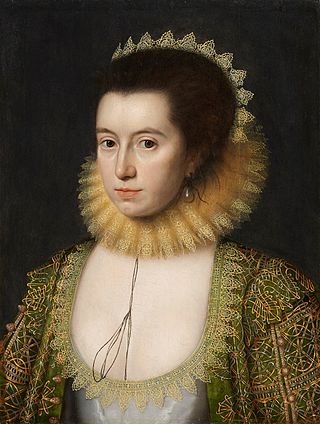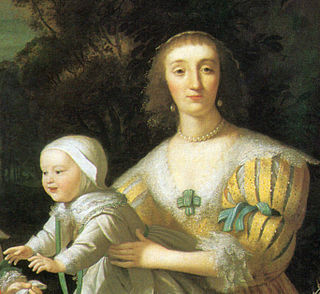
Lady Anne Clifford, Countess of Dorset, Pembroke and Montgomery, suo jure 14th Baroness de Clifford was an English peeress. In 1605 she inherited her father's ancient barony by writ and became suo jure 14th Baroness de Clifford. She was a patron of literature and as evidenced by her diary and many letters was a literary personage in her own right. She held the hereditary office of High Sheriff of Westmorland which role she exercised from 1653 to 1676.

Katherine Villiers, Duchess of Buckingham, Marchioness of Antrim, 18th Baroness de Ros of Helmsley was an English aristocrat. The daughter and heiress of Francis Manners, 6th Earl of Rutland, she was known as the richest woman in Britain outside of the royal family. She married first George Villiers, 1st Duke of Buckingham, the favourite, and possibly lover, of King James I of England; and secondly, she married the Irish peer Randal MacDonnell, 1st Marquess of Antrim.

Katherine Howard, Countess of Suffolk was an English court office holder who served as lady-in-waiting to the queen consort of England, Anne of Denmark.

Burley, or Burley-on-the-Hill, is a village and civil parish in the county of Rutland in the East Midlands of England. It is located two miles (3 km) north-east of Oakham. The population of the civil parish was 577 at the 2001 census, including Egleton, but reducing to 325 at the 2011 census.

Roger Manners, 5th Earl of Rutland was the eldest surviving son of John Manners, 4th Earl of Rutland and his wife, Elizabeth nee Charleton. He travelled across Europe, took part in military campaigns led by the Earl of Essex, and was a participant of Essex's rebellion against Queen Elizabeth I. He was favoured by James I, and honoured by his contemporaries as a man of great intelligence and talent. He enjoyed the friendship of some of the most prominent writers and artists of the Elizabethan age and Jacobean age. In 1603 he led an Embassy to Denmark, homeland of James' Queen Anne of Denmark.

The Masque of Blackness was an early Jacobean era masque, first performed at the Stuart Court in the Banqueting Hall of Whitehall Palace on Twelfth Night, 6 January 1605. It was written by Ben Jonson at the request of Anne of Denmark, the queen consort of King James I, who wished the masquers to be disguised as Africans. Anne was one of the performers in the masque along with her court ladies, all of whom appeared in blackface makeup. In a ceremony earlier on the day, Prince Charles, Anne's second son was given the title of Duke of York.
The Masque of Queens, Celebrated From the House of Fame is one of the earlier works in the series of masques that Ben Jonson composed for the House of Stuart in the early 17th century. Performed at Whitehall Palace on 2 February 1609, it marks a notable development in the masque form, in that Jonson defines and elaborates the anti-masque for the first time in its pages.
The Golden Age Restored was a Jacobean era masque, written by Ben Jonson and designed by Inigo Jones; it was performed on 1 January and 6 January 1616, almost certainly at Whitehall Palace.
Mercury Vindicated from the Alchemists at Court is a Jacobean-era masque, written by Ben Jonson and designed by Inigo Jones. It was performed at Whitehall Palace on Twelfth Night, 6 January 1615. King James I liked it so much that he ordered a repeat performance the following Sunday, 8 January.
The Masque of Augurs was a Jacobean era masque, written by Ben Jonson and designed by Inigo Jones. It was performed, most likely, on Twelfth Night, 6 January 1622.

The Vision of the Twelve Goddesses was an early Jacobean-era masque, written by Samuel Daniel and performed in the Great Hall of Hampton Court Palace on the evening of Sunday, 8 January 1604. One of the earliest of the Stuart Court masques, staged when the new dynasty had been in power less than a year and was closely engaged in peace negotiations with Spain, The Vision of the Twelve Goddesses stood as a precedent and a pattern for the many masques that followed during the next four decades.
Luminalia or The Festival of Light was a late Caroline era masque or "operatic show", with an English libretto by Sir William Davenant, designs by Inigo Jones, and music by composer Nicholas Lanier. Performed by Queen Henrietta Maria and her ladies in waiting on Shrove Tuesday, 6 February 1638, it was one of the last and most spectacular of the masques staged at the Stuart Court.
The Vision of Delight was a Jacobean era masque written by Ben Jonson. It was most likely performed on Twelfth Night, 6 January 1617 in the Banqueting House at Whitehall Palace, and repeated on 19 January that year.
Lovers Made Men, alternatively titled The Masque of Lethe or The Masque at Lord Hay's, was a Jacobean era masque, written by Ben Jonson, designed by Inigo Jones, and with music composed by Nicholas Lanier. It was performed on Saturday 22 February 1617, and was significant in the development and acceptance of opera in seventeenth-century England.
News from the New World Discovered in the Moon was a Jacobean era masque, written by Ben Jonson; it was first performed before King James I on 7 January 1620, with a second performance on 29 February the same year. Jonson's text comments on significant recent developments in astronomy and journalism. The text of the masque was first published in the second folio collection of Jonson's works in 1641.

The Whitehall group is a term applied to a small circle of art connoisseurs, collectors, and patrons, closely associated with King Charles I, who introduced a taste for the Italian old masters to England. The term usually includes the advisors and agents who facilitated the group's acquisition of works of art.
John Wolfgang Rumler was a German physician and apothecary in Augsburg, known for his Observationes medicae, who eventually served the English royal family in the households of Prince of Wales, Queen Anne, King James and Charles I of England. He is also credited with making blackface theatrical grease-paint.
The Entertainment of the Two Kings of Great Britain and Denmark or The Hours was written by Ben Jonson and performed at Theobalds House on 24 July 1606. John Harington of Kelston described another masque of Solomon and Sheba, performed one day at Theobalds after dinner. There is some doubt over Harington's account. In May 1607 another masque An Entertainment of the King James and Queen Anne at Theobalds was performed when the keys of the house were given to Anne of Denmark.
Frances Knyvet or Knyvett (1583–1605) was an English courtier who performed in masques.
Cecily Manners, Countess of Rutland was an English aristocrat.